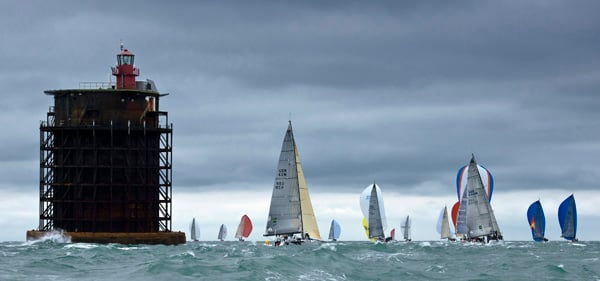Displaying items by tag: Offshore Race
17 Boat Fleet to Contest ISORA Coastal Training Race
A 17-boat fleet can expect light winds for Saturday's ISORA Training Race as part of the Viking Marine Coastal Series off Dun Laoghaire Harbour.
The race is the last before June 9th's Dun Laoghaire to Dingle Race and thus provides an opportunity for some race practise before the 320-miler in 12 days time.
Joining the ISORA Coastal fleet on Dublin Bay for the first time is Searcher, a new Sunfast 3600 to the bay.
Another new addition is Blaoga, a Dufour 45se from Howth Yacht Club.
 The 17-boat ISORA fleet for the Dublin Bay Coastal training race
The 17-boat ISORA fleet for the Dublin Bay Coastal training race
The 35-mile race is forecast to get underway at a new start time of 10 am in East South East winds of less than 5 mph.
 George Sisk's XP44 Wow is ISORA training tomorrow Photo: Afloat
George Sisk's XP44 Wow is ISORA training tomorrow Photo: Afloat
The course is as follows:
- STARTING LINE at Dun Laoghaire Outfall Buoy.
- ISORA Dublin Virtual Mark (P) N53 17.110 W6 00.100
- Kish Light (S)
- Virtual Mark 1 (P) N53 19.000 W5 35.500
- Kish Light (P)
- ISORA Dublin Virtual Mark (S) N53 17.110 W6 00.100
- FINISH LINE at Dun Laoghaire Pier Heads.
- RL Sailing briefing this evening 20.00
 The ISORA training race course from Dun Laoghaire to Dun Laoghaire
The ISORA training race course from Dun Laoghaire to Dun Laoghaire
Live Dublin Bay webcams
Ireland Hold Overall Lead But 'Dark, Wet Night' Ahead
The 17.00 BST sched showed Anthony O'Leary's Antix second among the big boats, David Dwyer's marinerscove.ie second in the mid-sized fleet and Robert Davies' Roxy 6 second among the small boats. With these results the Irish team would be on 44.5 points ahead of France Blue and Hong Kong tied in second on 71.5. GBR Red holds fourth on 86.5, followed by France Yellow in fifth.
As conditions improved following a damp and misty start to the 180-mile offshore race in the Rolex Commodores’ Cup, the three boats representing the Irish Cruiser Racing Association are maintaining good position at the front of their respective classes as the fleet settles in for a long night of beating westwards.
Other boats have already retired from the race after the breezy start off the Royal Yacht Squadron in West Cowes at 10.30am local time today. A brisk passage eastwards with a favourable tide saw the lead change as the fleet remained bunched. After passing the forts off Portsmouth and into open water close to Bembridge Ledge, the bigger boats started to pull away.
The 28-boats are racing in wind against tide conditions on the course westwards to Poole Fairway buoy before the smaller boats retrace their route back to Cowes for an expected finish during Wednesday. The larger boats have their courses extended further westwards from Poole towards Swanage.

“They’re setting down solidly after a hectic start,” said Barry Rose, ICRA Commodore. “Antix came out of it quite well on the northern end of the line while marinerscove.ie and Roxy were in a lot of traffic at the busy leeward end of the line. They’re now in quite promising positions.”
At the team briefing this morning, skippers and navigators heard that a lot will happen overnight which will be decisive as a front is expected come through which could lead to a change in wind and conditions; this could prove critical.
On estimated results this evening, Ireland continues to hold the overall lead of the event with strong challenges emerging from both France Blue and Hong Kong.
The 30 strong Rolex Commodores' Cup fleet shot off east down the Solent this morning with the wind and tide but under a grey rain-filled sky at the start of their high points scoring offshore race. The course for the 10 teams is full of zigzags taking them first out towards Selsey Bill while tonight they will be heading west along the bottom of the Isle of Wight en route for a mark off Poole Harbour. At this point the three classes will race slightly different courses before the run back east tomorrow morning that should see them finishing off a line to the west of Portsmouth Harbour sometime tomorrow afternoon.
At 17.00 BST Simon Henning's Alice II, a Farr 45, and the longest, highest rated yacht in the race, was approaching the Owers turning mark, the easternmost on the course, while the chasing pack were spread five to thirty-nautical miles astern of her. It seems likely that Alice II will steal a march on her Class 1 rivals, as her rounding of the Owers should coincide with the tide turning westbound, while those behind will face a further hour or two punching into it. Already Alice II in the GBR White team looks to be leading the big boat class on corrected time.
The absent Géry Trentesaux, the Frenchman who was instrumental in his country winning the Rolex Commodores' Cup in 2006 and 2002, would be proud. The First 40, Coup de Coeur, he co-owns with UNCL Commodore Marc de Saint Denis was leading Class 2 on handicap at 17.00 BST as part of the France Blue team. Meanwhile, in Class 3, it was the turn of the Hong Kong team to head the standings, with Christopher Opielok's Corby 36, Rockall III.
In the small boat class, Marc Alperovitch's A-35 Prime Time in France Yellow was holding fifth. Alperovitch said he had been pleased with their progress. Heading down the eastern Solent they had seen 20 knots but late in the afternoon the wind had dropped to 14 knots – less than forecast. "It has dropped earlier than planned," he reported. "Normally when the wind drops we should have a clear sky, but that is not the case at all. But maybe there is less pressure."
Just ahead of them, the crew on board Jim Macgregor's Elan 410 Premier Flair, lying seventh on handicap, were contemplating the night ahead and the lumpy conditions this evening heading west with the wind against the tide. "It was quite unpleasant earlier: wet and windy and horrible – good British summertime stuff," commented crew woman Jody Slater adding that on board they were seeing 16 knots from the southwest. "It is quite pleasant now. The wave action is a little uncomfortable, but apart from that is all right. It has stopped raining, which I am deeply happy about. Tonight hopefully won't be too unpleasant. It is supposed to be wind against tide. Unfortunately as one of the people taking seasickness pills, I don't look forward to the beating."
Owner Jim Macgregor had not managed to achieve his plan to use his boat's longer waterline length to shake off the smaller Corby designs. Macgregor, who pilots ships in and out of Poole harbour for a living and is father of the World Match Racing No.1 Lucy, said prior to the start that his crew, including Olympic 470 sailor Ben Saxton, comprised mostly inshore sailors. "Hopefully we'll stay awake tonight!"
This morning Simon Shaw, skipper on Michael Williamson's Summit 40 White Heat, the big boat in GBR Red, walked the course. "At around 5-6pm we get as far east as we are going to go and then it will be a long 12 hour beat all the way to Weymouth for us, around the back of the island. The tide is with us initially and then we are against on the mainland shore just under the Needles, so there will be a lot of tidal strategy in those areas and around Poole.
"It is going to be a really dark night. It is going to be wet – for us that beat is going to be the focus of the race really and the ability of crews to keep their boats trucking through the evening period. Our boat is a little tweaky so it will be doubly hard for us to keep it on the numbers in that environment." Shaw reckoned that they might rotate the helm and the main sheet trimmer to ensure they remained alert. They are expecting the wind to veer from the southwest back into the northwest tonight before settling back into the southwest tomorrow.
This evening as the teams prepare for a sleepless night on the rail, the British crews will be picturing the French teams sitting down below for a lavish dinner. In fact, the British might be getting the better deal. On White Heat they have a casserole to heat up for dinner, which will be eaten from dog bowls. On Prime Time Marc Alperovitch says they will be eating less palatable freeze-dried. "I love it – it reminds me of the Rolex Fastnet!"
Two yachts have retired to date: Cracklin Rosie (Class 1) and Artemis (Class 2) both from GBR Black.
The 2010 Rolex Commodores' Cup Long Offshore Race continues tomorrow, Wednesday, with the yachts expected to finish by the early afternoon. The forecast wind overnight is for 12 – 15 knots from the west and southwest. Tracking and provisional rankings available at: http://commodorescup.rorc.org/fleet-tracking/2010-live-offshore-tracking.html
Top Five Teams - Provisional Positions after completion of 4 races (Long Offshore not included)
Team / Points / Place
Ireland / 24.5 / 1
GBR Red / 49 / 2
France Blue / 51.5 / 3
Hong Kong / 54 / 4
France Yellow /59 / 5
The class positions that are updated every 15 minutes can be viewed online as follows:
Tracker: http://rorc.geovoile.org/commodorescup/
Class 1: http://admin.octracker.net/data/standings.aspx?id2=193
Class 2: http://admin.octracker.net/data/standings.aspx?id2=195
Class 3: http://admin.octracker.net/data/standings.aspx?id2=196





























































